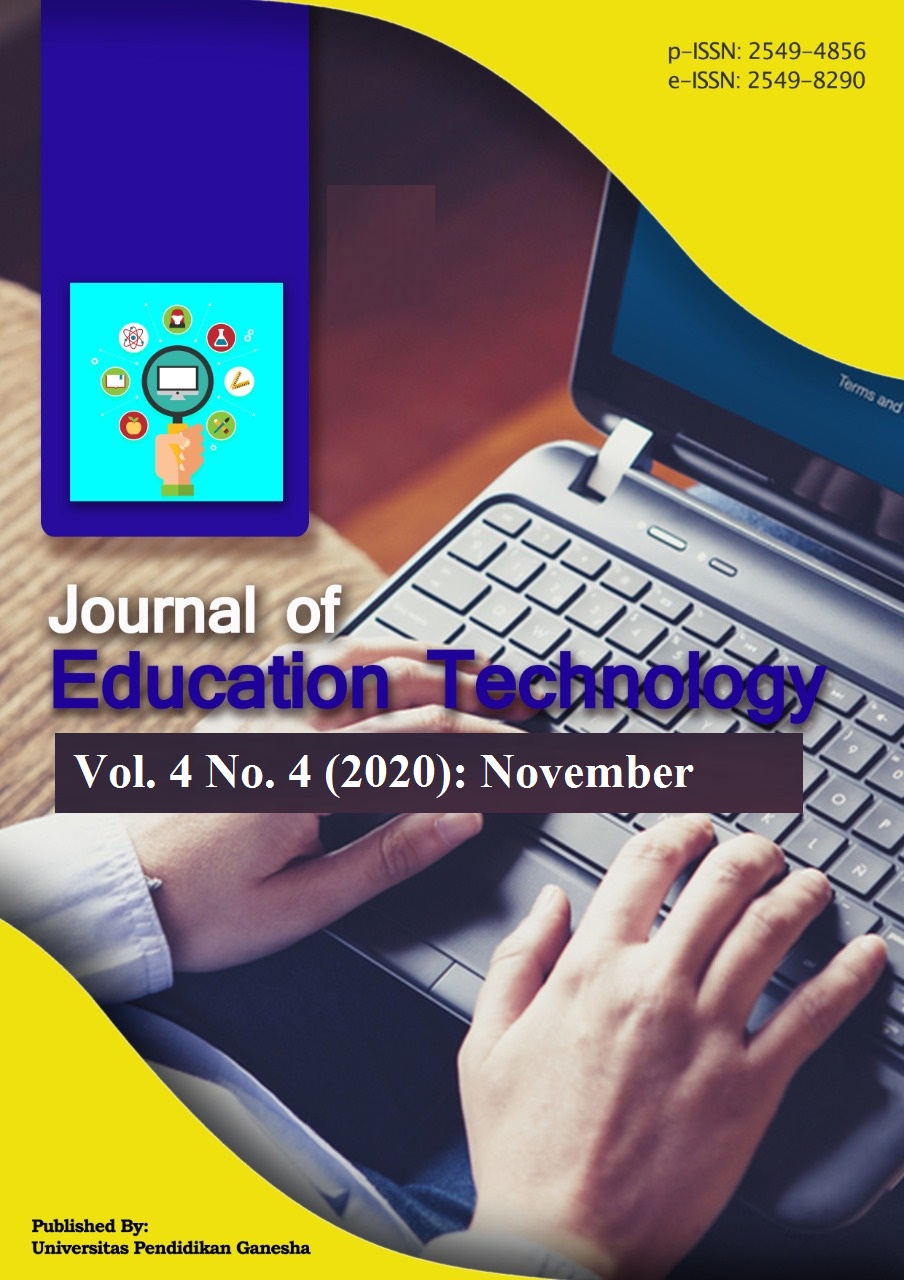Utilization of Classcraft in Developing Positive Student Behavior
DOI:
https://doi.org/10.23887/jet.v4i4.29611Keywords:
classcraft, the use positive attitudeAbstract
Affective assessment in distance learning has a great challenge. One of the media that can be used as well as motivated students is ClassCraft. Meanwhile, some limited persons can implement this media. This research aimed at analyzing the procedures of usingClassCraftin developingstudents' positive attitudes. The research subject was a lecturer and students of English Language Education, Faculty of Teacher Training, Dwijendra University. This research was a descriptive qualitative study that elaborates the implementation of ClassCraft to develop a positive attitude. The data were collected through observation and interview using observation and interview guide. The data were analyzed using qualitative data analysis by Milles and Huberman (1994). The finding showed that the implementation of ClassCraft was implemented in three stages; planning, implementing, and evaluating. It can be a guidance of implementing ClassCraft in developing students' positive behaviors.
References
Adibsereshki, N., Abkenar, S. J., Ashoori, M., &Mirzamani, M. (2015). The effectiveness of using reinforcements in the classroom on the academic achievement of students with intellectual disabilities. Journal of Intellectual Disabilities, 19(1), 83–93. https://doi.org/10.1177/1744629514559313
Allen, K., & Friedman, B. (2010). Affective learning: A taxonomy for teaching social work values. Journal of Social Work Values and Ethics, 7(2), 1–12.
Anwar, S., Marlena, N., &Wulandari, R. (2018). Efektifitas Gamification Berbasis Blended Learning Pada Mata Kuliah Pendidikan Ekonomi. JurnalEkonomi Pendidikan Dan Kewirausahaan, 6(1), 5. https://doi.org/10.26740/jepk.v6n1.p5-14
Arsa, I. M. R., &Winahya, A. E. (2012). Evaluasipembelajaranberbasiskarakter di sekolahmenengahkejuruan. TEKNOLOGI DAN KEJURUAN, 35(2), 155-162.
Audina, I., Susetyo, S., & Arifin, M. (2019). PenilaianSikapSiswaDalamPembelajaran Bahasa Indonesia Oleh Guru Kelas Vii Di Smp Negeri 1 Kota Bengkulu. JurnalIlmiah KORPUS, 2(2), 167–173. https://doi.org/10.33369/jik.v2i2.6520.
Bakar, R. (2014). the Effect of Learning Motivation on Student'S Productive Competencies in Vocational High School, West Sumatra. International Journal of Asian Social Science, 4(6), 2226–5139. Retrieved from http://www.aessweb.com/journals/5007
Brett, A. M., Smith, M. L., Price, E. A., Huitt, W. G., Brett, C., & Overview, W. (2017). Affective Domain 1 Overview of the Affective Domain, (March 2012).
Chiarelli, M., Szabo, S., & Williams, S. (2015). Using Classdojo To Help With Classroom Management During Guided Reading. Texas Journal of Literacy Education, 3(2), 81–88.
Courville, K. (2011). Technology and Its Use in Education: Present Roles and Future Prospects. Online Submission, 1–19.
Fatmasari, R., &Suripto. (2018). Teaching Practice in Distance Education Context. SHS Web of Conferences, 42, 00099. https://doi.org/10.1051/shsconf/20184200099.
Fauzan, F., & Arifin, F. (2019). The Effectiveness of Google Classroom Media on the Students' Learning Outcomes of Madrasah Ibtidaiyah Teacher Education Department. Al Ibtida: Jurnal Pendidikan Guru MI, 6(2), 271. https://doi.org/10.24235/al.ibtida.snj.v6i2.5149
Gruenwald, H. (2020). Videoconferencing during Corona Times, (July).
Hattie, J., & Timperley, H. (2007). The Power of Feedback. Review of Educational Research, 77(1), 81-112. doi: 10.3102/003465430298487
Hoque, S. R. (2013). "Effect of Reinforcement on Teaching – Learning Process." IOSR Journal of Humanities and Social Science, 7(1), 13–16. https://doi.org/10.9790/0837-0711316
Kusaeri, (2018). PenilaianSikapdalamPembelajaranMatematika. JurnalInovasi Pendidikan. 2(2). https://bit.ly/2Uygcv0.
Leontyeva, I. A. (2018). Modern distance learning technologies in higher education: Introduction problems. Eurasia Journal of Mathematics, Science and Technology Education, 14(10), 1–8. https://doi.org/10.29333/ejmste/92284.
Manning, M. L. (2009). Strategies for Improving Students Behavior. http://go.hrw.com/resources/go_sc/gen/HSTPR054.PDF.
Miles, B. Matthew & Huberman, A. Michael. 1994. Qualitative Data Analysis. Second Edition. London: Sage Publication.
Naeini, F. H., & Masood, M. (2012). Effect of educational computer games on student creativity. Research Journal of Applied Sciences, Engineering and Technology, 4(23), 5280–5284.
Otto, R. (2018). Using Classcraft As A Positive Behavioral Intervention Strategy In The Classroom. School of Education Student Capstone Projects. 239. https://digitalcommons.hamline.edu/hse_cp/239
Papadakis, S. &Kalogiannakis, M. (2017). Using Gamification for Supporting an Introductory Programming Course. The Case of ClassCraft in a Secondary Education Classroom. Research Gate. https://bit.ly/3me9WVb.
Prawiyogi, Purnanugraha, Fakhry, &Firmansyah (2020). Efektifitaspembelajaranjarakjauhterhadappembelajaransiswa di SDIT CendekiaPurwakarta. Jurnal Pendidikan Dasar. E-ISSN 2549-5801. http://journal.unj.ac.id/unj/index.php/jpd/article/view/15347/8748
Raja, R., &Nagasubramani, P.C. (2018). Impact of Modern Technology. Journal of Applied and Advanced Research. 3, 33–35. https://doi.org/10.4324/9780203168899_chapter_10.
Riswanto, A., &Aryani, S. (2017). Learning motivation and student achievement : description analysis and relationships both. COUNS-EDU: The International Journal of Counseling and Education, 2(1), 42. https://doi.org/10.23916/002017026010.
Rohman, D. (2012). Implementasi Pendidikan Karakter pada Proses Pembelajaran Kelas X SMA Negeri 1 WelahanKabupatenJepara. (Skripsi), Universitas Negeri Semarang. http://lib.unnes.ac.id/17138/1/1102408040.pdf.
Sayem, A. S. M., Taylor, B., Mcclanachan, M., &Mumtahina, U. (2017). Effective use of Zoom technology and instructional videos to improve engagement and success of distance students in Engineering. Australasian Association for Engineering Education (AAEE 2017), 1(1), 1–6. Retrieved from https://www.researchgate.net/publication/323268816_Effective_use_of_Zoom_technology_and_instructional_videos_to_improve_engagement_and_success_of_distance_students_in_Engineering.
Sudijono, A. (2013). PengantarEvaluasi Pendidikan Jakarta: PT Raja GrafindoPersada.
Sukmawati, S., &Nensia, N. (2019). The Role of Google Classroom in ELT. International Journal for Educational and Vocational Studies, 1(2), 142–145. https://doi.org/10.29103/ijevs.v1i2.1526
Susila, I. K. D. (2019). Reinforcement used in teaching young learners. WidyaAcarya. 10 (2) ISSN NO. 2085-0018. http://ejournal.undwi.ac.id/index.php/widyaaccarya/article/view/77.
Trigueros, I.R. (2020). ClassCraft as a Resource to Implement Gamification in English-Medium Instruction. Research Gate. https://bit.ly/3lC.
Yanuarista, P.L., Wahyono, H., &Wulandari, D. (2015) Analisisplagiarismedalampenulisanskripsimahasiswa program studi s1 pendidikanekonomipembangunantahun 2010 -2014 universitas negeri malang. JPE. 8 (1). http://journal2.um.ac.id/index.php/jpe/article/download/1632/915.
Downloads
Published
How to Cite
Issue
Section
License
Authors who publish with the Journal of Education Technology agree to the following terms:
- Authors retain copyright and grant the journal the right of first publication with the work simultaneously licensed under a Creative Commons Attribution License (CC BY-SA 4.0) that allows others to share the work with an acknowledgment of the work's authorship and initial publication in this journal.
- Authors are able to enter into separate, additional contractual arrangements for the non-exclusive distribution of the journal's published version of the work (e.g., post it to an institutional repository or publish it in a book), with an acknowledgment of its initial publication in this journal.
- Authors are permitted and encouraged to post their work online (e.g., in institutional repositories or on their website) prior to and during the submission process, as it can lead to productive exchanges, as well as earlier and greater citation of published work. (See The Effect of Open Access)
















